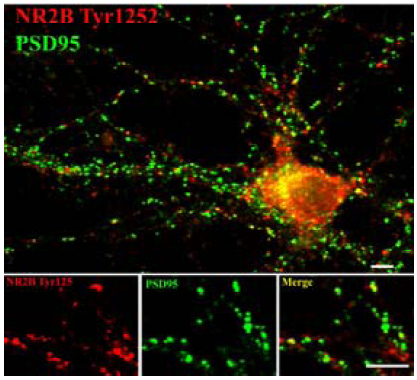Phospho-Tyr1252 NMDA Receptor NR2B Subunit Antibody
Affinity purified rabbit polyclonal antibody
- SPECIFICATION
- CITATIONS
- PROTOCOLS
- BACKGROUND

Application
| IHC, WB |
|---|---|
| Primary Accession | Q00960 |
| Reactivity | Rat |
| Predicted | Bovine, Chicken, Human, Mouse, Monkey, Zebrafish |
| Host | Rabbit |
| Clonality | polyclonal |
| Calculated MW | 180 KDa |
| Gene ID | 24410 |
|---|---|
| Gene Name | GRIN2B |
| Other Names | Glutamate receptor ionotropic, NMDA 2B, GluN2B, Glutamate [NMDA] receptor subunit epsilon-2, N-methyl D-aspartate receptor subtype 2B, NMDAR2B, NR2B, Grin2b |
| Target/Specificity | Synthetic phospho-peptide corresponding to amino acid residues surrounding Tyr1252 conjugated to KLH. |
| Dilution | WB~~ 1:1000 IHC~~ 1:400 |
| Format | Prepared from rabbit serum by affinity purification via sequential chromatography on phospho- and dephosphopeptide affinity columns. |
| Antibody Specificity | Specific for ~180k NMDAR NR2B subunit protein phosphorylated at Tyr1252. Immunolabeling of the NMDA NR2B subunit band is blocked by the phosphopeptide used as the antigen but not by the corresponding dephosphopeptide. Immunolabeling is also blocked by λ-phosphatase treatment. The antibody may also show some slight reactivity with Tyr1246 of NR2A. |
| Storage | Maintain refrigerated at 2-8°C for up to 6 months. For long term storage store at -20°C in small aliquots to prevent freeze-thaw cycles. |
| Precautions | Phospho-Tyr1252 NMDA Receptor NR2B Subunit Antibody is for research use only and not for use in diagnostic or therapeutic procedures. |
| Shipping | Blue Ice |

Thousands of laboratories across the world have published research that depended on the performance of antibodies from Abcepta to advance their research. Check out links to articles that cite our products in major peer-reviewed journals, organized by research category.
info@abcepta.com, and receive a free "I Love Antibodies" mug.
Provided below are standard protocols that you may find useful for product applications.
Background
The NMDA receptor (NMDAR) plays an essential role in memory, neuronal development and it has also been implicated in several disorders of the central nervous system including Alzheimer’s, epilepsy and ischemic neuronal cell death (Grosshans et al., 2002; Wenthold et al., 2003; Carroll and Zukin, 2002). The rat NMDAR1 (NR1) was the first subunit of the NMDAR to be cloned. The NR1 protein can form NMDA activated channels when expressed in Xenopus oocytes but the currents in such channels are much smaller than those seen in situ. Channels with more physiological characteristics are produced when the NR1 subunit is combined with one or more of the NMDAR2 (NR2 A-D) subunits (Ishii et al., 1993). Phosphorylation of Tyr1252 is thought to potentiate NMDA receptor-dependent influx of calcium (Takasu et al., 2002).
References
Carroll RC, Zukin RS (2002) NMDA-receptor trafficking and targeting: implications for synaptic transmission and plasticity. Trends Neurosci 25:571-577.
Grosshans DR, Clayton DA, Coultrap SJ, Browning MD (2002) LTP leads to rapid surface expression of NMDA but not AMPA receptors in adult rat CA1. Nat Neurosci 5:27-33.
Ishii T, Moriyoshi K, Sugihara H, Sakurada K, Kadotani H, Yokoi M, Akazawa C, Shigemoto R, Mizuno N, Masu M, Nakanishi S (1993) Molecular characterization of the family of the N-methyl- D-aspartate receptor subunits. J Biol Chem 268:2836-2843.
Takasu, MA, Dalva, MB, Zigmond, RE, Greenberg, ME (2002) Modulation of NMDA Receptor -Dependent Calcium Influx and Gene Expression Through EphB Receptors. Science 295:491-495.
Wenthold RJ, Prybylowski K, Standley S, Sans N, Petralia RS (2003) Trafficking of NMDA receptors. Annu Rev Pharmacol Toxicol 43:335-358.
Tianna R. Hicklin, Peter H. Wu, Richard A. Radcliffe, Ronald K. Freund, Susan M. Goebel-Goody, Paulo R. Correa, William R. Proctor, Paul J. Lombroso, and Michael D. Browning (2011) Alcohol inhibition of the NMDA receptor function, long-term potentiation, and fear learning requires striatal-enriched protein tyrosine phosphatase PNAS, Apr 2011; 108: 6650 - 6655.
If you have used an Abcepta product and would like to share how it has performed, please click on the "Submit Review" button and provide the requested information. Our staff will examine and post your review and contact you if needed.
If you have any additional inquiries please email technical services at tech@abcepta.com.













 Foundational characteristics of cancer include proliferation, angiogenesis, migration, evasion of apoptosis, and cellular immortality. Find key markers for these cellular processes and antibodies to detect them.
Foundational characteristics of cancer include proliferation, angiogenesis, migration, evasion of apoptosis, and cellular immortality. Find key markers for these cellular processes and antibodies to detect them. The SUMOplot™ Analysis Program predicts and scores sumoylation sites in your protein. SUMOylation is a post-translational modification involved in various cellular processes, such as nuclear-cytosolic transport, transcriptional regulation, apoptosis, protein stability, response to stress, and progression through the cell cycle.
The SUMOplot™ Analysis Program predicts and scores sumoylation sites in your protein. SUMOylation is a post-translational modification involved in various cellular processes, such as nuclear-cytosolic transport, transcriptional regulation, apoptosis, protein stability, response to stress, and progression through the cell cycle. The Autophagy Receptor Motif Plotter predicts and scores autophagy receptor binding sites in your protein. Identifying proteins connected to this pathway is critical to understanding the role of autophagy in physiological as well as pathological processes such as development, differentiation, neurodegenerative diseases, stress, infection, and cancer.
The Autophagy Receptor Motif Plotter predicts and scores autophagy receptor binding sites in your protein. Identifying proteins connected to this pathway is critical to understanding the role of autophagy in physiological as well as pathological processes such as development, differentiation, neurodegenerative diseases, stress, infection, and cancer.



